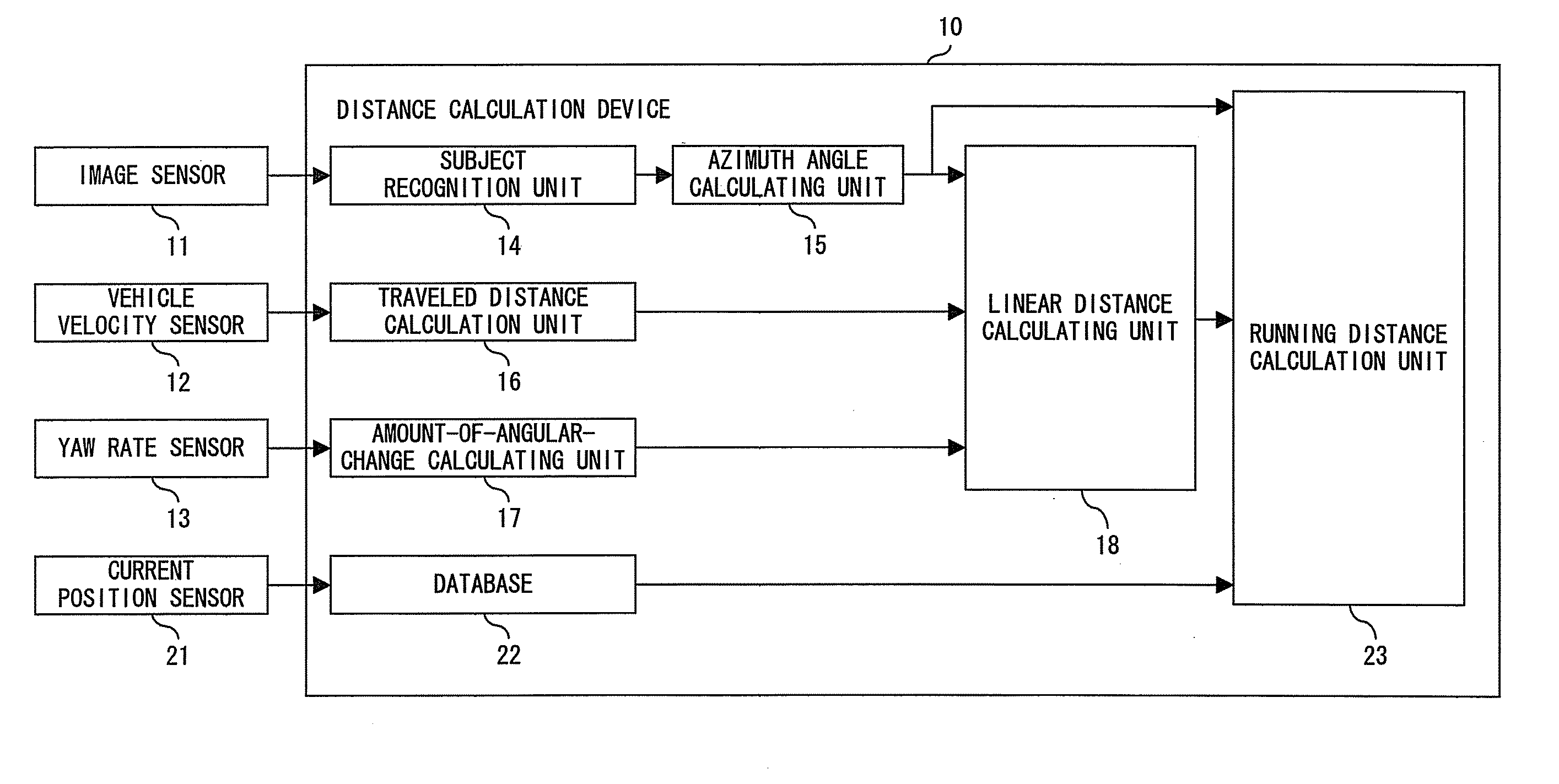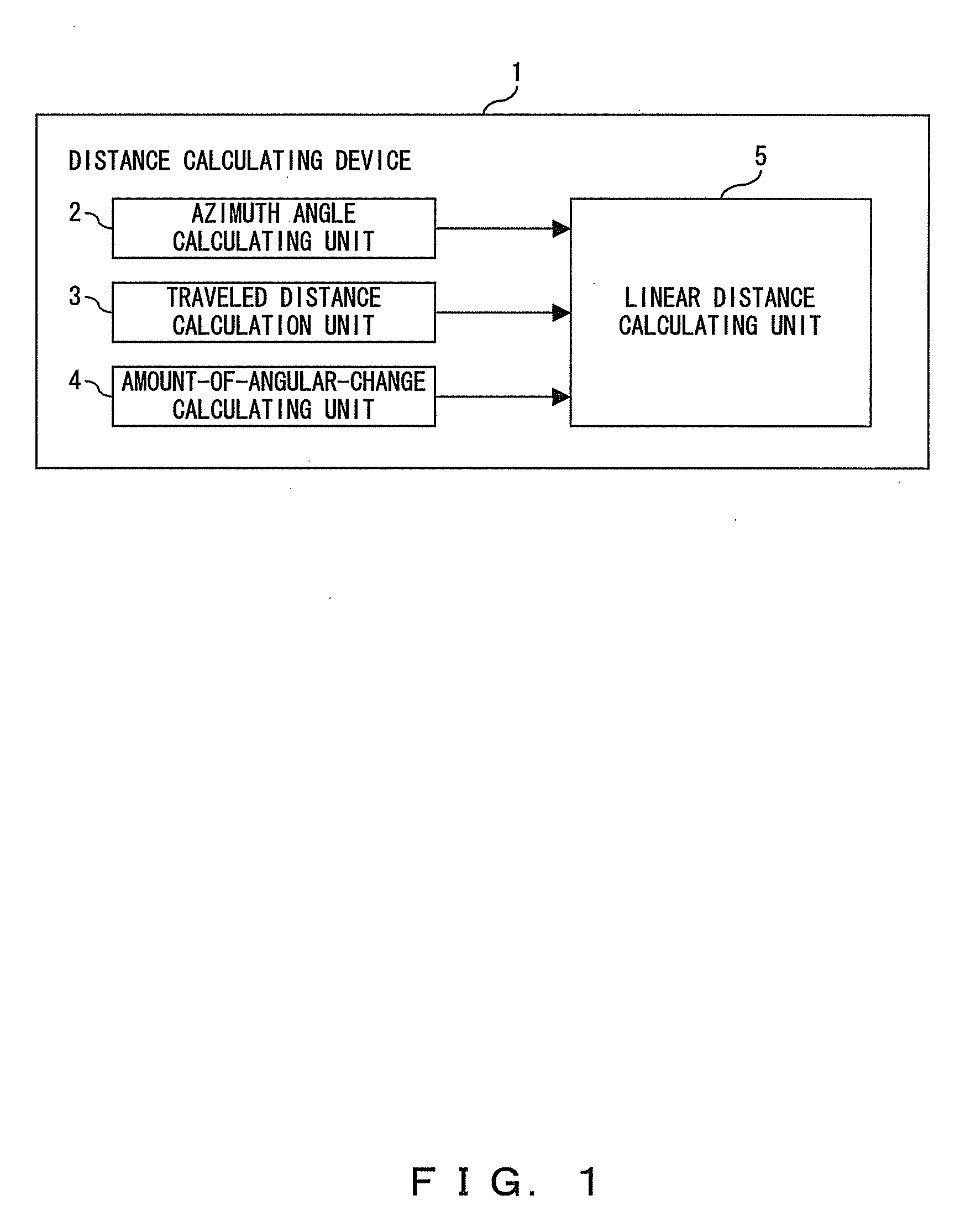Distance calculation device and calculation program
- Summary
- Abstract
- Description
- Claims
- Application Information
AI Technical Summary
Benefits of technology
Problems solved by technology
Method used
Image
Examples
embodiment 1
[0064]FIG. 3 is a flowchart of the entire process of calculating the distance according to the present invention. When the process is started as shown in FIG. 3, the position of a subject is recognized using the output of the image sensor 11, for example, the coordinates of the red or blue signal of a traffic signal in the image are output in step S1, the angle made by the traveling direction of a vehicle and the direction of the subject, that is, the azimuth angle, is calculated in step S2, the traveled distance of the vehicle between two points of time, that is, the traveled distance in the process interval of 100 ms, is calculated using the output of the vehicle velocity sensor 12 in step S3, and the amount of angular change on the vertical axis of the vehicle is calculated using the output of the yaw rate sensor 13 in step S4.
[0065] The processes in steps S1 to S4 can be independently performed, and the order of the processes can be changed, or the processes can be performed in ...
embodiment 3
[0095]FIG. 13 is the entire flowchart of the traveling direction distance calculating process according to the In FIG. 13, when the process is started, the subject recognition unit 14 first recognizes the position of the subject as shown in FIG. 4, the elevation angle in the direction of the subject is calculated in step 42, the traveling traveled distance is calculated in step S43, the pitching angle is calculated using the output of the inclination angle calculation unit 26 in step S44, the distance in the traveling direction is calculated as a component parallel to the traveling direction of the vehicle of the vector indicating the distance from the current position of the vehicle to the subject in step S45, thereby terminating the process.
[0096] The calculation of an inclination angle is explained below. FIGS. 14 and 15 are explanatory views of the method of calculating an inclination angle, and FIG. 16 is a flowchart of the inclination angle calculating process. FIG. 14 is an ...
embodiment 2
[0112] The running distance calculation unit 23 calculates the running distance using the output of the azimuth angle calculating unit 15, the output of the database 22, and the output of the traveling direction distance calculation unit 28. In the embodiment 2 shown in FIG. 9, the running distance calculation unit 23 calculates the running distance along the road to the subject using the output of the linear distance calculating unit 18, that is, the linear distance from the position of the vehicle to the subject. The process is shown in FIG. 10. The traveling direction distance calculation unit 28 shown in FIG. 22 calculates the distance X in the traveling direction of the vehicle as explained by referring to FIG. 17, and the current position of the vehicle and the linear distance to the subject is easily calculated using the output of the azimuth angle calculating unit 15, that is, ∠SA2S′. Therefore, using the linear distance, the running distance calculation unit 23 can calculat...
PUM
 Login to View More
Login to View More Abstract
Description
Claims
Application Information
 Login to View More
Login to View More - R&D
- Intellectual Property
- Life Sciences
- Materials
- Tech Scout
- Unparalleled Data Quality
- Higher Quality Content
- 60% Fewer Hallucinations
Browse by: Latest US Patents, China's latest patents, Technical Efficacy Thesaurus, Application Domain, Technology Topic, Popular Technical Reports.
© 2025 PatSnap. All rights reserved.Legal|Privacy policy|Modern Slavery Act Transparency Statement|Sitemap|About US| Contact US: help@patsnap.com



